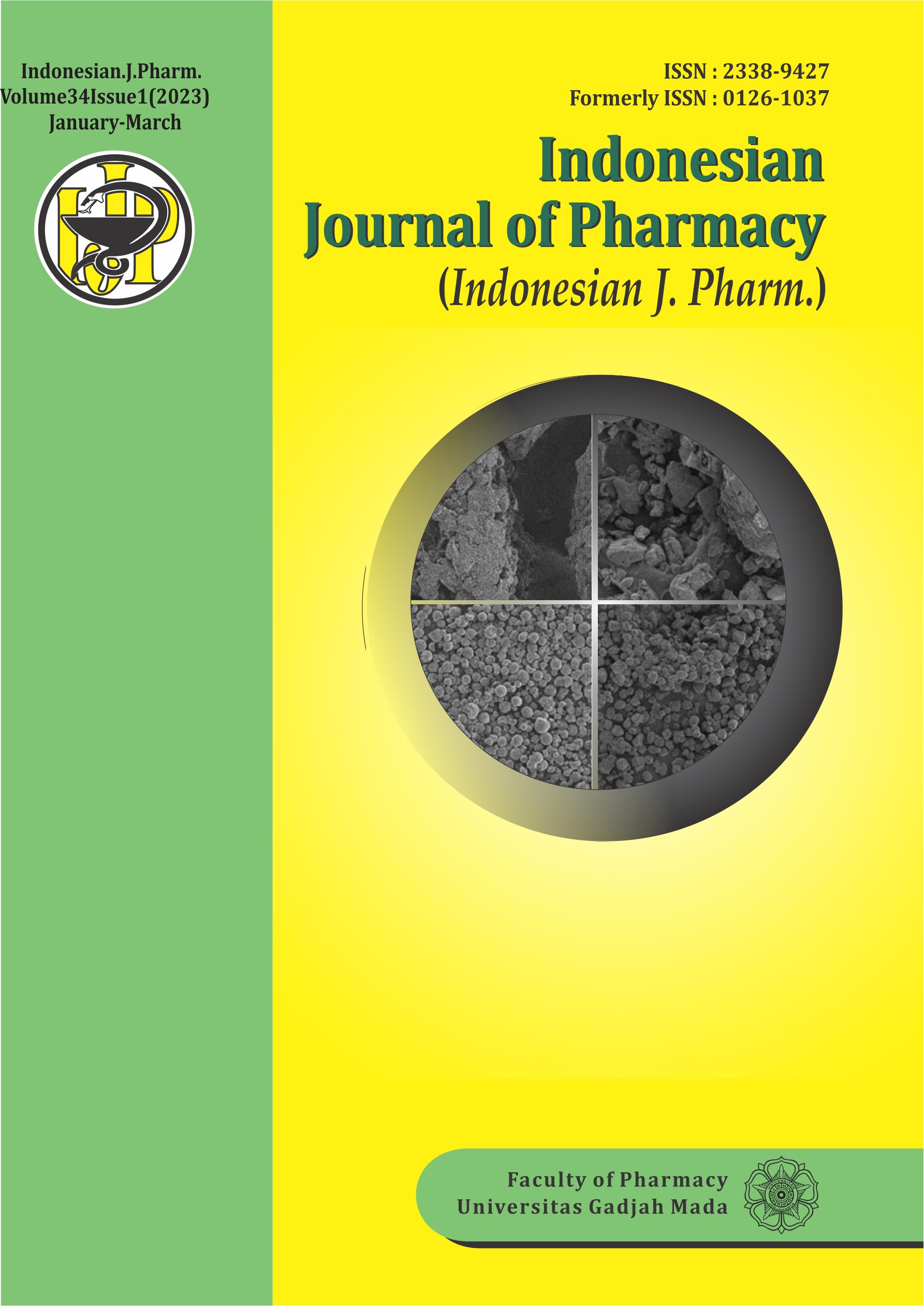Clindamycin Peel-off Mask Film, an Effective Formulation for C. acnes Treatment: Characterization and Microbiological Activity
Abstract
Clindamycin is the antibiotic of choice for treating Cutibacterium acnes (C. acnes) which was presented in various dosage forms such as topical solution, gel, and foam. In this current study, clindamycin was formulated as the peel-off mask gel, intending to form film, providing the drug release profile in a sustained manner leading to better antimicrobial efficacy and enabling peel-off after use. The peel-off mask gel was designed into many formulations with varying concentrations of film-forming agents. The major film-forming agent was 10 %w/w PVA that was combined with the additional film-forming agents PVP-K30 or SA. Clindamycin 1 %w/w was loaded in the selected formulations F18 (10 %w/w PVA and 20 %w/w PVP-K30) and F21 (10 %w/w PVA and 1.5 %w/w SA). The physical property evaluation of the peel-off mask gel showed that the types and concentrations of film-forming agents influenced the viscosity, spreadability, and film-forming ability. The film’s tensile strength indicating the preference of use was also determined. There was no interaction between the ingredients in the formulation evaluated by FT-IR, XRD, and DSC. The F18 and F21 formulations showed a good to very good spreadability and film-forming ability, a suitable tensile strength with a drying time of approximately 8 min, and pH 4-5. Both formulations provided the highest antimicrobial susceptibility for C. acnes compared to the blank film and the clindamycin solution indicating the potential to be developed as the new market formulation for acne treatment.
References
Alkhatib, H., Taha, M., Aiedeh, K., Bustanji, Y. & Sweileh, B. (2006). Synthesis and in vitro behavior of iron-crosslinked N-methyl and N-benzyl hydroxamated derivative of alginic acid as controlled release carriers. Eur. Polym. J, 42, 2464-2474. https://doi.org/ 10.1016/j.eurpolymj.2006.05.018
Andini, T., Yusriadi, Y. & Yuliet, Y. (2017). Optimization of film forming polyvinyl alcohol and propylene glycol humectant in pumpkin juice (Cucurbita moschata Duchesne) peel-off gel mask formula as antioxidants. J. Farm. Galenika, 3(2), 165-173. https://doi.org/10.22487/j24428744.0.v0.i0.8773
Andrade, J., González-Martínez, C. & Chiralt, A. (2020). The incorporation of carvacrol into poly (vinyl alcohol) films encapsulated in lecithin liposomes. Polymers, 12(497), 1-18. https://doi.org/10.3390/polym12020497
Chan, S.Y., Chung, Y.Y., Cheah, X.Z., Tan, E.Y.L. & Quah, J. (2015). The characterization and dissolution performances of spray dried solid dispersion of ketoprofen in hydrophilic carriers. Asian J. Pharm Sci, 10, 372-385. https://doi.org/10.1016/j.ajps.2015.04.003
Clinical and laboratory standards institute. (2020). CLSI supplement M100 Performance standards for antimicrobial susceptibility testing (30th ed.). Wayne, PA: Publisher.
Daemi, H. & Barikani, M. (2012). Synthesis and characterization of calcium alginate nanoparticles, sodium homopoly mannuronate salt and its calcium nanoparticles. Sci. Iran, 19, 2023-2028. https://doi.org/10.1016/j.scient.2012.10.005
Gloor, M. & Bauer, W. (1979). The facial mask as a basis of clindamycin therapy for acne vulgaris. Hautarzt, 30(7), 380-383.
Gupta, S., Pramanik, A.K., Kailath, A., Mishra, T., Guha, A., Nayar, S. & Sinha, A. (2009). Composition dependent structural modulations in transparent poly(vinyl alcohol) hydrogels. Colloids Surf. B, 74, 186-190. https://doi.org/10.1016/j.colsurfb.2009.07.015
Helmiyati. & Aprilliza, M. (2017). Characterization and properties of sodium alginate from brown algae used as an ecofriendly superabsorbent. IOP Conf. Ser. Mater. Sci. Eng, 188, 012019. https://doi.org /10.1088/1757-899X/188/1/012019
Jaipakdee, N., Pongjanyakul, T. & Limpongsa, E. (2018). Preparation and characterization of poly (vinyl alcohol)-poly (vinyl pyrrolidone) mucoadhesive buccal patches for delivery of lidocaine HCl. Int. J. Appl. Pharm, 10(1), 115-123. https://doi.org/10.22159/ijap.2018v10i1.23208
Lewandowska, K. (2005). The miscibility of poly(vinyl alcohol)/poly(N-vinylpyrro lidone) blends investigated in dilute solutions and solids. Eur. Polym. J, 41, 55-64. https://doi.org/10.1016/j.eurpolymj.2004.08.016
Mohamed, A.I., Abd-Motagaly, A.M., Ahmed, O.A.A., Amin, S. & Mohamed Ali A.I. (2017). Investigation of drug–polymer compatibility using chemometric-assisted UV-spectrophotometry. Pharmaceutics, 9(7), 1-13. https://doi.org/10.3390/pharmaceutics9010007
Nursal, F.K., Nining. & Rahmani, A. (2021). Effect of glycerin as plasticizer in formulation of grape seed oil (Vitis vinifera L.) emulgel peel-off mask. IOP Conf. Ser. Earth Environ. Sci, 819(1),012058. https://doi.org/10.1088/1755-1315/819/ 1/012058
Patel, P. & Patel, P. (2015). Formulation and evaluation of clindamycin HCl in situgel for vaginal application. Int. J. Pharm. Investig, 5(1), 50-56. https://doi.org/10.4103/2230-973X.147233
Pendekal, M.S. & Tegginamat, P.K. (2013). Hybrid drug delivery system for oropharyngeal, cervical and colorectal cancer - in vitro and in vivo evaluation. Saudi. Pharm. J, 21(2), 177-186. https://doi.org/10.1016/j.jsps.2012.07.002
Roselyne, M., Marc, P. & Oliver, D. (2014). Film forming complex, cosmetic composition comprising it and their use as peel-off film mask, European Patent 2979685A1.
Sudirman, S., Karo, A.K., Sukaryo, S.G., Adistiana, K.D. & Dahlan, K. (2020). Synthesis of nanofiber from polyvinyl alcohol (PVA)-collagen using electrospinning methods. J.Kim.Terap. Indones, 21(2), 55-65. https://doi.org/10.14203/jkti.v21i2.428
Tamaddon, L., Mostafavi, S.A., Karkhane, R., Esfahani, M.R., Dorkoosh, F.A. & Tehrani, M.R. (2015). Thermoanalytical characterization of clindamycin‑loaded intravitreal implants prepared by hot melt extrusion. Adv. Biomed. Res, 4(147), 1-9. https://doi.org/10.4103/2277-9175.1615 63
Teodorescu, M. & Bercea, M. (2015). Poly(vinylpyrrolidone) – a versatile polymer for biomedical and beyond medical applications. Polym. Plast. Technol. Eng, 54(9), 923-943.
https://doi.org/10.1080/03602559.2014.979506
Wetchakun, C., Puapermpoonsiri, U. & Sila-on, W. (2016). Effect of alcohol and co-film former on the physical and mechanical properties of facial mask formulations. IJPS, 11 (Supplement),25-32.
Xiao, S., Huang, R.Y.M. & Feng, X. (2006). Preparation and properties of trimesoyl chloride crosslinked poly(vinyl alcohol) membranes for pervaporation dehydration of isopropanol. J. Membr. Sci, 286(1), 245-254. https://doi.org/10.1016/j.memsci.2006.09.042
Zaenglein, A.L., Pathy, A.L., Schlosser, B.J., Stern, M., Boyer, K.M. & Bhushan, R. (2016). Guidelines of care for the management of acne vulgaris. J. Am. Acad. Dermatol, 74(5), 945-973. https://doi.org/10.1016/j.jaad.2015.12.037








